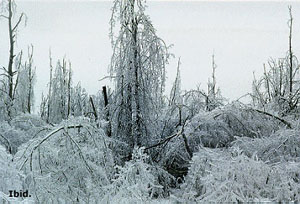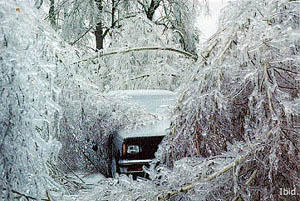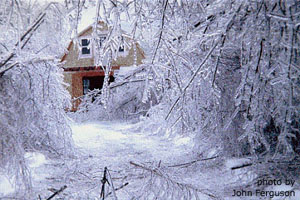The Great Ice
Storm of 1998
Vocabulary
Read the vocabulary terms to understand the reading better.
Force
A force is anything that can make an object change speed, shape, or direction through pushing or pulling on the object.
Structure
A structure is anything that is built or constructed, such as buildings and bridges.
Hydro Poles
Hydro poles are wooden poles to which hydro wires are attached to transmit electricity from place to place.
Transmission Towers
Transmission towers are tall steel structures that support high-voltage electrical power lines and help to transport power from the generating stations to the substations.
The Great Ice Storm of 1998
Winter often brings freezing rain to Canada and parts of the northern United States. Most of the time, a freezing rain storm lasts for only a few hours, so not much ice accumulates on objects such as bridges, buildings, and hydro poles, and natural structures such as trees.
Over six days in early January 1998, a series of five storms dumped freezing rain on some areas in the Canadian provinces of Ontario, Québec, and New Brunswick. In the United States, the states of New York and Maine were affected by the storms. In the areas that received the most freezing rain, so much ice accumulated that the series of storms became known as the Great Ice Storm of 1998.

Effects of the Great Ice Storm
In a freezing rain storm, layers of ice build-up on structures and everything else outdoors. The ice gets heavier as it gets thicker. When a very thick layer of ice builds up, the weight of the ice is a strong force that acts on structures. During the Great Ice Storm, many structures were not able to support the weight of the ice. This is what turned the storm into a major disaster.
The biggest problem caused by the storm was that many areas lost electricity. Over a million people in Ontario and Québec had no electricity. For some people, this meant no heat in their homes. A number of people died from the cold.
Why did the storm affect electricity? Electricity travels from power generating plants to homes and businesses through cables called power lines. In some places, tall metal structures called transmission towers support the power lines high above the ground. Along many streets, power lines are supported by tall wooden posts called hydro poles.
The storm put so much ice on transmission towers that many of these strong structures crumpled under the weight of the ice. As the transmission towers crumpled, power lines broke. In areas with hydro poles, a thick layer of ice formed around power lines. The power lines became so heavy that over 30 000 hydro poles could no longer stay standing. Power lines broke as hydro poles crashed to the ground.
During the Great Ice Storm, millions of trees fell down because they could not support the weight of all the ice on their branches. Some trees knocked down power lines as they fell. Other trees did major damage to homes and cars when they fell.
The Great Ice Storm of 1998 will long be remembered as one of the worst storms ever to hit North America.



To learn more about the Great Ice Storm of 1998, watch the video by CBC on YouTube.
Show What You Know!
Complete some questions about the reading selection by clicking “Begin Questions” below.









